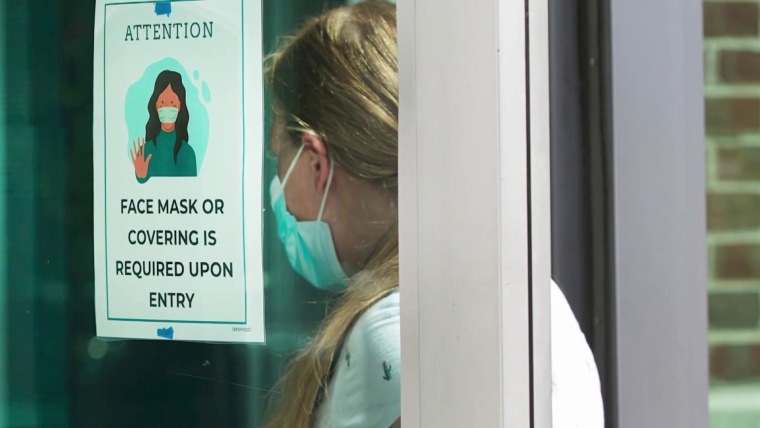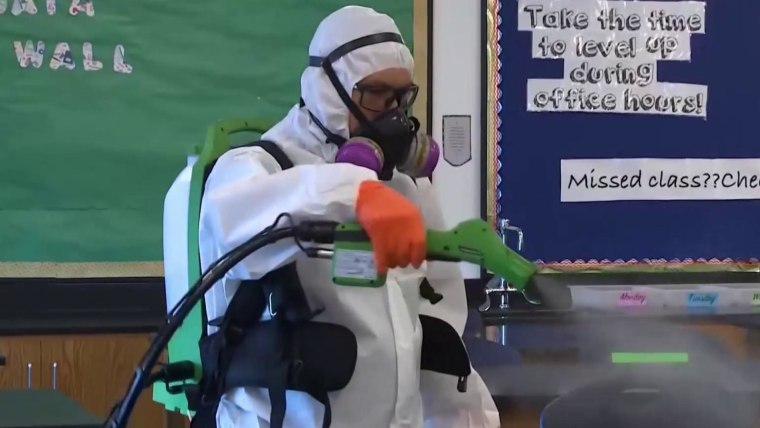As a nurse at two elementary schools, Michelle Lally of Rockford, Illinois, is used to looking after children's health. And she's not squeamish about being around sick students.
"On a good day before COVID, I'd get spit at, chewed on and bopped around by the kids all the time," said Lally, 64.
But Lally is dreading the coming school year, as the school district is giving parents the option of full-time in-person learning for elementary school students and two days in class for older students. Among her fears: that class sizes will be too large to observe social distancing and that the rules will be too vague or difficult to enforce.
"Some days I get anxious and teary. Other days I'm all over the place," she said. "I want to see the kids in person, but if there aren't any guidelines in place, we shouldn't go back. We aren't prepared as a nation."
Lally isn't the only one concerned. In interviews, educators and school staff members described intense fears about the virus's spreading among children, parents and staff members, as well as doubts that their districts are being given the tools to protect them.
"My parents are older. I don't live with them, but I see them a lot, and I'd be worried to accidentally spread something to them," said Jamie Wong, 33, a high school and middle school English teacher in Somerset, New Jersey. Her school, which is offering a blend of in-person and remote learning, has already had its opening pushed back a week.
Wong said she's worried that schools won't be able to follow through on a plan for long without first controlling the outbreak nationally.
"I've talked to a few students whose parents have chosen" remote learning, Wong said. "They're saying, 'What's the point of going to school since we'll all be back and home as soon as someone tests positive?'"
As schools open around the country, many educators sounded trapped between bad options: either return to facilities they don't feel are safe during an alarming national wave of new cases and deaths or return to remote learning, which they fear would leave students falling further behind.
"I'm torn, because teachers do the magic in the classroom, and you're right there to help the kids, but for me it's not worth the risk," said Mary Walther, a high school German teacher in Phoenix.
Walther gave her district high marks for having prepared its online-only reopening plan in advance, but she has also had to play unofficial IT consultant for teenagers and teachers alike in the first week as they work out the kinks. A colleague called her crying asking her to help set up an older computer.
According to an independent analysis by MCH Strategic Data, an institutional marketing data company, most school districts that have announced reopening plans will offer at least some classes in person, with about half opting for a "hybrid" of in-person and virtual learning.
Full coverage of the coronavirus outbreak
Manuel Rustin, 40, will return virtually to teaching history, government and a course on hip-hop to high school students in Pasadena, California, this week after Gov. Gavin Newsom decided to start the year online. While Rustin said he agrees with the plan given safety concerns, he worries that the decision was made far too late to give teachers and students time to prepare.
"We're going into the fall essentially with the same model we had in the spring, and I don't know anyone who said the spring was a success," he said. "I just feel like the summer's been squandered, because teachers like myself would have really appreciated having more guidance in what effective online teaching looks like."
Last semester, Rustin's students struggled to get online and stay engaged while often looking after younger relatives or taking on paid work to help their parents through financial struggles related to the pandemic. With the state still working to improve support services like day care programs, he's worried that the same patterns will hold.
"Sometimes I'd be in contact with a student and then not hear from them for two weeks and then hear from them again," he said. "I'm super concerned that more students will fall through the cracks without having that daily interaction with teachers and counselors."
Some teachers are glad to be back in person. Lisa Geller, a college counselor at a boarding school in Maine, said she was "very comfortable" with her school's safety plan even though she is in a high-risk health category herself.
"I'm not being Pollyanna, but I think we've taken precautions," she said. Cases are low in the area, students are tested before they arrive and are housed in individual rooms, and there's a separate building to quarantine any positive or suspected cases going forward.
"Before the students came, I had a lot of anxiety," she said. "I've read some articles about college students not complying with safety guidelines, but our kids have been very compliant."
A teacher at a private school in Brooklyn, New York, who asked that her name not be used for fear of retaliation, said pressure from parents to reopen this semester had created tensions with staff members who were more reluctant to return. While she's glad to be teaching young students in person again, she's worried that it's "virtually impossible" for them to follow social distancing rules.
"I know it is extremely negative thinking, but I don't feel appreciated by the parents who demanded we get back to work during a pandemic with seemingly zero regard for how we felt about it," she said. "I feel as if teachers are the sacrificial guinea pigs."
Educators have emerged as a powerful voice against some of the more aggressive reopening plans, with many complaining that their safety isn't being fully taken into account.
In Washington, D.C., teachers dropped body bags outside Mayor Muriel Bowser's office ahead of her decision on a reopening plan. Shortly afterward, Bowser announced that classes would take place remotely to start the school year, following adjoining districts in Virginia and Maryland. In states that are moving forward with in-person classes, like Florida, teachers have prewritten their obituaries in protest.
Children are far less likely than adults to suffer serious consequences from COVID-19, but researchers are still working to determine how likely they are to transmit the virus to one another and to more vulnerable adults. While public health experts have largely cautioned against reopening in coronavirus hot spots, some have argued that schools in places with lower infection rates may safely reopen.
A report by the American Academy of Pediatrics, which has advocated for in-person classes if feasible, found that over 97,000 children were diagnosed with COVID-19 in the first two weeks of July. Twitter and Facebook recently blocked a campaign video in which President Donald Trump falsely said children are "almost immune" to the virus.
Bradley Marianno, a professor of education at the University of Nevada, Las Vegas, who has been tracking the response of teachers unions to the crisis, said unions have frequently demanded protections like temperature checks, regular testing and staff and space to accommodate reduced class sizes.
But with state and local budgets already under strain from the pandemic, meeting those goals has been difficult. In Marianno's state, Nevada, the governor and legislators approved cuts in school funding amid a drop in tax revenue, which inflamed the reopening debate. The Clark County Education Association, which represents educators in Las Vegas, put out a $14 million proposal to test all staff members before returning to full-time in-person classes, among other safety measures, but it ended up endorsing remote learning along with local school officials.
"It's an impossible budget situation in Nevada in particular," Marianno said. "I think that's part of why the decision was made in Clark County school districts to move toward distance learning to start, because it was becoming clear that, given rising case counts, it would be next to impossible to implement all of the demands that the union wanted to ensure their staff was safe."
Some teachers suggested that the development of a COVID-19 vaccine was needed for them to feel truly comfortable returning.
Others named a variety of safety measures they hoped might at least help address their concerns. Among them: mask requirements, which some schools don't have, smaller classroom sizes, upgraded ventilation systems and staff members to check for symptoms at the door.
The White House and Congress have yet to approve a new round of funding for school reopening plans, and talks have broken down between Republican and Democratic leaders. The Democratic-led House passed a bill in May that would have approved $58 billion for K-12 schools, while Trump and Senate Republican leaders backed a $70 billion plan in July but also pushed to make large tranches of aid contingent on schools' reopening with in-person classes.
Download the NBC News app for breaking news and politics
The American Federation of Teachers last month authorized potential strikes by local chapters as a "last resort" if officials try to send them into schools they don't consider safe.
In addition to demanding at least $116 billion to implement new safety measures, they've asked districts to set benchmarks for COVID-19 transmission, including 14-day declines in cases and rates of positive tests below 5 percent, before even considering in-person classes.
But some teachers say even that standard is inadequate. A movement of educators called Refuse to Return went viral with a petition demanding that counties go 14 days without any coronavirus cases at all before reopening schools, with local chapters popping up to adopt its message.
Harley Poston, a high school history teacher in Oakland, California, who started the petition, said he feared that officials had become too willing to accept the spread of the coronavirus compared to other countries in a way that endangered staff.
"We just didn't see in the national debate the priority of eliminating this disease," he said.
And while he has concerns about remote learning for his students, "I would rather deal with that challenge than deal with the threat of being sent to my death," he said.
"between" - Google News
August 17, 2020 at 06:00PM
https://ift.tt/2Q21SsB
Educators feel trapped between bad options as the school year begins - NBC News
"between" - Google News
https://ift.tt/2WkNqP8
https://ift.tt/2WkjZfX
Bagikan Berita Ini

















0 Response to "Educators feel trapped between bad options as the school year begins - NBC News"
Post a Comment